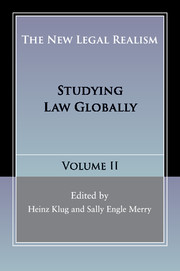Book contents
- Frontmatter
- Dedication
- Contents
- List of contributors
- Preface to The New Legal Realism, Volumes I and II
- 1 Introduction
- Section I The Globalization of Law
- Section II The Global Transfer of Norms
- Section III global institutions and the changing roles of judges and lawyers
- Section IV Global Justice
- 11 The Irreconcilable Goals of Transitional Justice
- 12 Pushing States to Prosecute Atrocity: The Inter-American Court and Positive Complementarity
- 13 When Law and Social Science Diverge: Causation in the International Law of Incitement to Commit Genocide
- Index
- References
12 - Pushing States to Prosecute Atrocity: The Inter-American Court and Positive Complementarity
from Section IV - Global Justice
Published online by Cambridge University Press: 05 May 2016
- Frontmatter
- Dedication
- Contents
- List of contributors
- Preface to The New Legal Realism, Volumes I and II
- 1 Introduction
- Section I The Globalization of Law
- Section II The Global Transfer of Norms
- Section III global institutions and the changing roles of judges and lawyers
- Section IV Global Justice
- 11 The Irreconcilable Goals of Transitional Justice
- 12 Pushing States to Prosecute Atrocity: The Inter-American Court and Positive Complementarity
- 13 When Law and Social Science Diverge: Causation in the International Law of Incitement to Commit Genocide
- Index
- References
Summary
Introduction
A key issue regarding the future of the International Criminal Court (ICC) is the evolution of its complementarity regime. Under Article 17 of the Rome Statute, the ICC can take jurisdiction only if a state is “unable or unwilling” to prosecute for genocide, crimes against humanity, or war crimes. The doctrine of complementarity was originally designed as a way to respect sovereignty: states that wanted to avoid international prosecution could do so by initiating domestic prosecutions. But here is the rub: it is the ICC itself that holds the power to decide whether domestic proceedings pass muster, or whether they are flawed and show that the state is “unable or unwilling” to prosecute. Complementarity is thus understood by some as allowing the ICC to monitor the domestic criminal system's response to the crimes that could trigger ICC jurisdiction. Under this vision of “positive complementarity,” the ICC has the potential to become not only a site of criminal adjudication but, perhaps more ambitiously, a new kind of global monitoring body that bolsters domestic judiciaries and fosters accountability for international crimes at the national level (Burke-White 2008).
In trying to imagine how such a positive complementarity regime might evolve, and, in particular, how it can be tailored to contribute to post-conflict settings, the experience of the human rights system of the Americas proves vital. Created by the Organization of American States (OAS) in 1959, the Inter-American System (IAS) was born into and shaped by a region in which regime change and state-sponsored violence against civilian populations abounded. The dockets of the Inter-American Court and Commission have been filled with human rights violations that also amount to crimes against humanity, war crimes, and genocide. Through the years, and in parallel to the emergence of a system of international criminal courts, the Court and Commission have quietly developed their own system of oversight of situations of state-sponsored crime and transitional justice. Both organs regularly instruct states to investigate and punish for acts that are international crimes (Huneeus 2013). They then closely monitor state compliance, issuing reports on the advance of national prosecutions and making suggestions for further progress. They also instruct states to compensate victims with material and symbolic reparations, and to provide society sites of remembrance and information about the underlying crimes.
- Type
- Chapter
- Information
- The New Legal RealismStudying Law Globally, pp. 225 - 241Publisher: Cambridge University PressPrint publication year: 2016



